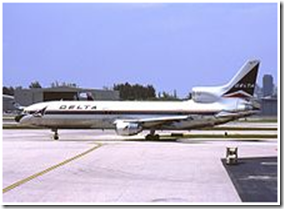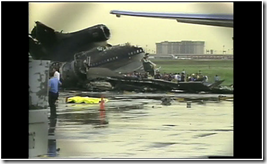An August Afternoon of Tragedy
On the first Friday in August, a small group of single adults from my church gathered in a home in Arlington, Texas. It was a social get-together and discussion about forming an official single-adult group at the church.
It’s been twenty-nine years since that gathering, so I don’t remember who the other people in attendance were. I don’t even remember how we happened to turn the television on.
It was raining, but nothing about the weather seemed out of place to us. That is, until we saw the horrible pictures the news crews were sending from DFW Airport.
An airplane depends upon the speed of the air rushing over and under its wings to provide the lift to keep it in the air. Normally, airspeed is a relatively stable thing. It increases as the pilot increases the engine thrust or lowers the plane’s nose to descend, and it decreases as the pilot reduces the engine thrust or raises the plane’s nose to climb. These increases and decreases are relatively gradual, not instantaneous.
Weather can throw monkey wrenches into this normal stability. Wind direction and velocity vary with altitude. While the wind on the ground may be from the south at ten miles per hour, at 30,000 feet above that same point, it may be from the north at twenty miles per hour. Again, normally this change in direction and velocity is gradual as the altitude increases. A thousand foot change in altitude may bring on a change of a few compass points in direction and a couple of miles per hour in velocity, but it’s gradual enough not to be particularly noticeable.
On this particular afternoon, Delta Flight 191 was inbound to DFW from Fort Lauderdale on its way to Los Angeles. Unknown to the pilots, there was a phenomenon known as wind shear taking place just off the approach end of runway 17C.
A Lockheed L1011 similar to that of Flight 191
In wind shear, the air at a given altitude is markedly different in velocity and/or direction from that immediately above it. A plane flying at 149 knots airspeed (171 mph), which was the landing speed for this Delta L-1011, and heading into, say, a fifteen knot headwind would have a groundspeed of 134 knots. The wind would be holding back the plane’s speed in reference to the ground by that fifteen knots.
If the plane then descended through a wind shear into a level where the wind was coming from behind at fifteen knots, the groundspeed would still be 134 knots, but the airspeed would suddenly drop to only 119 knots. That sudden shift in the wind would have no instantaneous effect on the airplane’s speed with reference to the ground, but that’s not what keeps a plane in the air. The airspeed in this example would suddenly drop from 149 knots—the plane’s landing speed—to 119 knots—which would be too slow to sustain flight, and it would fall to the ground.
This is perhaps a bit oversimplified and exaggerated, but it illustrates the effect of wind shear. I don’t know the various speeds actually involved for this airplane, but the net effect was that the plane hit the group short of the runway and not in a proper configuration to land.
It touched the ground about 1.2 miles north of the runway, where it bounced back into the air. It came back down again crossing State Highway 114, a freeway running by the north end of the airport, where it demolished a black Toyota, killing its driver. Then it skidded onto the airport property where it collided with two 15,000 gallon water tanks and exploded. Out of 163 passengers and crew members, 136 were killed in addition to the Toyota driver.
We completely lost interest in our party as we stood glued to the television screen. That afternoon, and for days afterward, the media continued to show view after view of the crash and the rescue efforts that followed. I don’t know about people who viewed this around the world, but those of us here in the Metroplex that afternoon have the scene indelibly imprinted on our brains. I doubt any of us will ever forget it.
Where were you on August 2, 1985? What do you remember about this tragedy?
——————————————
WANA: We may not have it all together, but together we have it all.
——————————————
For more information about David N. Walker, click the “About” tab above.
For more information about his books, click on “Books” above.
Contact him at dnwalkertx (at) gmail (dot) com or tweet him at @davidnwalkertx.
Filed under: Uncategorized Tagged: Advice, Authorship, Caring, David N. Walker Christian Author, David N. Walker Historical Fiction Author, Delta Air Lines, Delta Flight 191, DFW Airport, Fancy Series, friends, Heaven Sent, Life, Life experience, Life lessons, Life truths, Life values, People, Personal development, Self-help 






